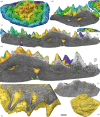Romundina and the evolutionary origin of teeth
- PMID: 26109615
- PMCID: PMC4528481
- DOI: 10.1098/rsbl.2015.0326
Romundina and the evolutionary origin of teeth
Abstract
Theories on the origin of vertebrate teeth have long focused on chondrichthyans as reflecting a primitive condition-but this is better informed by the extinct placoderms, which constitute a sister clade or grade to the living gnathostomes. Here, we show that 'supragnathal' toothplates from the acanthothoracid placoderm Romundina stellina comprise multi-cuspid teeth, each composed of an enameloid cap and core of dentine. These were added sequentially, approximately circumferentially, about a pioneer tooth. Teeth are bound to a bony plate that grew with the addition of marginal teeth. Homologous toothplates in arthrodire placoderms exhibit a more ordered arrangement of teeth that lack enameloid, but their organization into a gnathal, bound by layers of cellular bone associated with the addition of each successional tooth, is the same. The presence of enameloid in the teeth of Romundina suggests that it has been lost in other placoderms. Its covariation in the teeth and dermal skeleton of placoderms suggests a lack of independence early in the evolution of jawed vertebrates. It also appears that the dentition-manifest as discrete gnathal ossifications-was developmentally discrete from the jaws during this formative episode of vertebrate evolution.
Keywords: dental development; evolution; jawed vertebrates; modularity; placoderm.
Figures


Similar articles
-
Origin and evolution of gnathostome dentitions: a question of teeth and pharyngeal denticles in placoderms.Biol Rev Camb Philos Soc. 2005 May;80(2):303-45. doi: 10.1017/s1464793104006682. Biol Rev Camb Philos Soc. 2005. PMID: 15921053 Review.
-
Development of teeth and jaws in the earliest jawed vertebrates.Nature. 2012 Nov 29;491(7426):748-51. doi: 10.1038/nature11555. Epub 2012 Oct 17. Nature. 2012. PMID: 23075852
-
Separate evolutionary origins of teeth from evidence in fossil jawed vertebrates.Science. 2003 Feb 21;299(5610):1235-6. doi: 10.1126/science.1079623. Science. 2003. PMID: 12595693
-
Placoderm fishes, pharyngeal denticles, and the vertebrate dentition.J Morphol. 2003 Sep;257(3):289-307. doi: 10.1002/jmor.10124. J Morphol. 2003. PMID: 12833371
-
The genetic basis of modularity in the development and evolution of the vertebrate dentition.Philos Trans R Soc Lond B Biol Sci. 2001 Oct 29;356(1414):1633-53. doi: 10.1098/rstb.2001.0917. Philos Trans R Soc Lond B Biol Sci. 2001. PMID: 11604128 Free PMC article. Review.
Cited by
-
Diverse stem-chondrichthyan oral structures and evidence for an independently acquired acanthodid dentition.R Soc Open Sci. 2021 Nov 10;8(11):210822. doi: 10.1098/rsos.210822. eCollection 2021 Nov. R Soc Open Sci. 2021. PMID: 34804566 Free PMC article.
-
The conundrum of pharyngeal teeth origin: the role of germ layers, pouches, and gill slits.Biol Rev Camb Philos Soc. 2022 Feb;97(1):414-447. doi: 10.1111/brv.12805. Epub 2021 Oct 13. Biol Rev Camb Philos Soc. 2022. PMID: 34647411 Free PMC article. Review.
-
A new 'acanthothoracid' placoderm from the Arctic Canada (Early Devonian) and its bearing on the evolution of jaws and teeth.R Soc Open Sci. 2025 Sep 3;12(9):250837. doi: 10.1098/rsos.250837. eCollection 2025 Sep. R Soc Open Sci. 2025. PMID: 40904996 Free PMC article.
-
Morphogenesis of pteraspid heterostracan oral plates and the evolutionary origin of teeth.R Soc Open Sci. 2024 Dec 18;11(12):240836. doi: 10.1098/rsos.240836. eCollection 2024 Dec. R Soc Open Sci. 2024. PMID: 39698157 Free PMC article.
-
Microstructure and development of the dermal ossicles of Antarctopelta oliveroi (Dinosauria, Ankylosauria): A complex morphogenetic system deciphered through three-dimensional X-ray microtomography.J Anat. 2025 Sep-Oct;247(3-4):665-681. doi: 10.1111/joa.14159. Epub 2024 Nov 5. J Anat. 2025. PMID: 39497679 Free PMC article.
References
-
- Goujet D, Young GC. 2004. Placoderm anatomy and phylogeny: new insights. In Recent advances in the origin and early radiation of vertebrates (eds Arratia G, Wilson MVH, Cloutier R.), pp. 109–126. München: Pfeil.
Publication types
MeSH terms
LinkOut - more resources
Full Text Sources
Other Literature Sources
Miscellaneous

